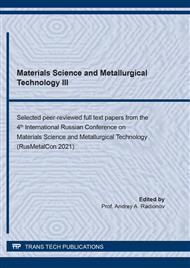[1]
O.A. Nasibullina, M. Yu. Pechenkina, Comparison of characteristics of St3 in a free and annealed state, IOP Conference Series: Materials Science and Engineering. 1155 (2021) 012002.
DOI: 10.1088/1757-899x/1155/1/012002
Google Scholar
[2]
O.A. Nasibullina, Studying the effect of tempering temperature during heat treatment on the corrosion resistance of 13MN6 steel samples, Solid State Phenomena. 316 (2021) 203-207.
DOI: 10.4028/www.scientific.net/ssp.316.203
Google Scholar
[3]
I.G. Abdullin, A.G. Gareev, Corrosion fatigue durability of pipe steel in carbonate-bicarbonate media, Fiziko-Khimicheskaya Mekhanika Materialov. 29(5) (1993) 97-98.
DOI: 10.1007/bf00558780
Google Scholar
[4]
Z.R. Mazina, R.R. Tlyasheva, Development of the method for assessment of potential zones of destruction of process pipelines, IOP Conference Series: Earth and Environmental Science. 459(3) (2020) 032037.
DOI: 10.1088/1755-1315/459/3/032037
Google Scholar
[5]
A.S. Tyusenkov, O.A. Nasibullina, Inhibitory anticorrosive protection of oilfield equipment, IOP Conference Series: Materials Science and Engineering. 687(6) (2019) 066021.
DOI: 10.1088/1757-899x/687/6/066021
Google Scholar
[6]
D.V. Karetnikov, R.G. Rizvanov, A.M. Fairushin, K.S. Kolokhov, Increasing the reliability of oil and gas equipment working in the conditions of steep temperature gradients, Welding International. 27(7) (2013) 557-560.
DOI: 10.1080/09507116.2012.715949
Google Scholar
[7]
E.S. Gaysi, Y.A. Frolov, O.A. Nasibullina, Estimate tank quality margin, IOP Conference Series: Earth and Environmental Science. 459(3) (2020) 032055.
DOI: 10.1088/1755-1315/459/3/032055
Google Scholar
[8]
R.G. Rizvanov, R.G. Abdeev, N.L. Matveev, R.G. Ryskulov, A.I. Shenknekht A.F. Insafutdinov, Effect of the geometry of the shell/elliptical-bottom contact zone on the stress state of pressure vessels, Chemical and Petroleum Engineering. 36 (2000) 3.
DOI: 10.1007/bf02463460
Google Scholar
[9]
I.R. Kuzeev, I.G. Ibragimov, M.I. Bayazitov, S.N. Davydov, I.R. Khairudinov, Steel corrosion prevention in coking residual petroleum stocks, Chem. and Technology of Fuels and Oils. 22(3) (1985) 111-113.
DOI: 10.1007/bf00726125
Google Scholar
[10]
M.Z. Zaripov, A.M. Fairushin, D.V. Karetnikov, Conditions of possible application of vibration processing in the course of welding, Materials Science Forum. 946 (2019) 883-888.
DOI: 10.4028/www.scientific.net/msf.946.883
Google Scholar
[11]
A.S. Tyusenkov, O.A. Nasibullina, Corrosion of tubing of oil fields, IOP Conference Series: Materials Science and Engineering. 687(6) (2019) 066016.
DOI: 10.1088/1757-899x/687/6/066016
Google Scholar
[12]
O.A. Nasibullina, R.G. Rizvanov, Studying of causes of destruction of the main gas pipeline, Materials Science Forum. 989 (2020) 28-32.
DOI: 10.4028/www.scientific.net/msf.989.28
Google Scholar
[13]
I.R. Kuzeev, I.G. Ibragimov, M.I. Bayazitov, S.N. Davydov, I.R. Khairudinov, Steel corrosion prevention in coking residual petroleum stocks, Chem. and Technology of Fuels and Oils. 22(3) (1985) 111-113.
DOI: 10.1007/bf00726125
Google Scholar
[14]
R.G. Rizvanov, D.Sh. Mulikov, D.V. Karetnikov, A.M. Fairushin, A.S. Tokarev, Evaluation of the possibility of obtaining tube-to-tube sheet welded joints of 15Cr5Mo steel by alternative technological process, IOP Conf. Series: Materials Science and Engineering. 317 (2018) 01207.
DOI: 10.1088/1757-899x/317/1/012077
Google Scholar
[15]
O.A. Nasibullina, A.G. Gareev, Destruction patterns of X70 steel sample, possessing cracks of corrosion-mechanical origin, under cyclic loading, Materials Science Forum. 946 (2019) 20-24.
DOI: 10.4028/www.scientific.net/msf.946.20
Google Scholar
[16]
I.G. Abdullin, A.G. Gareev, Corrosion-fatigue durability of pipe steel in carbonate-bicarbonate medium, Materials Science. 29(5) (1994) 539-541.
DOI: 10.1007/bf00558780
Google Scholar
[17]
M.V. Vakulenko, N.V. Zharinova, Logic-sense model of primary oil processing plant safety assurance, IOP Conference Series: Materials Science and Engineering. 862(6) (2020) 062022.
DOI: 10.1088/1757-899x/862/6/062022
Google Scholar
[18]
A.L. Karpov, M.Z. Zaripov, A.M. Fayrushin, Analysis of methods of protection of inner surface of welds of field pipelines, IOP Conference Series: Earth and Environmental Science. 666(4) (2021) 042037.
DOI: 10.1088/1755-1315/666/4/042037
Google Scholar


